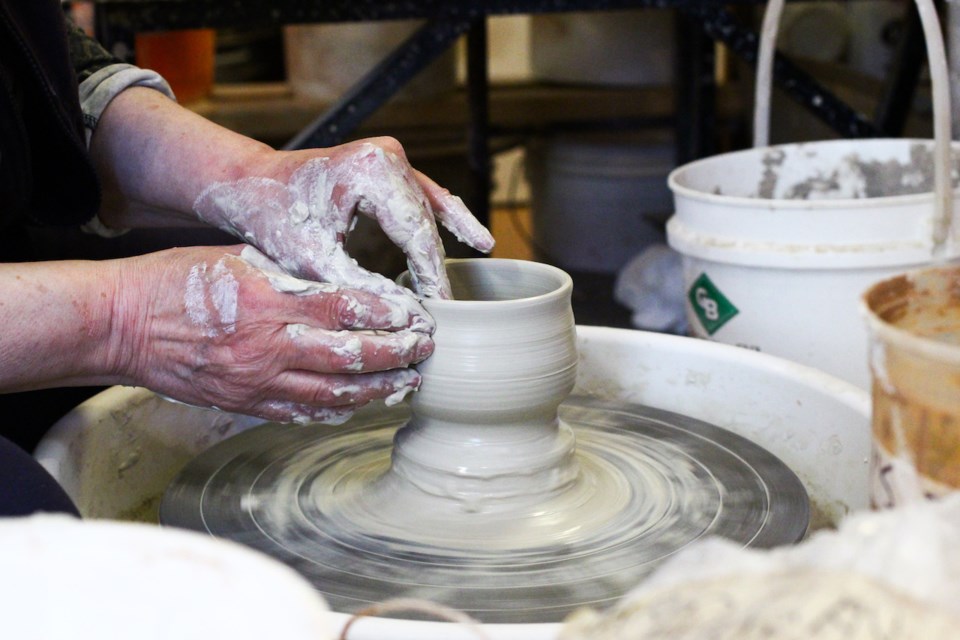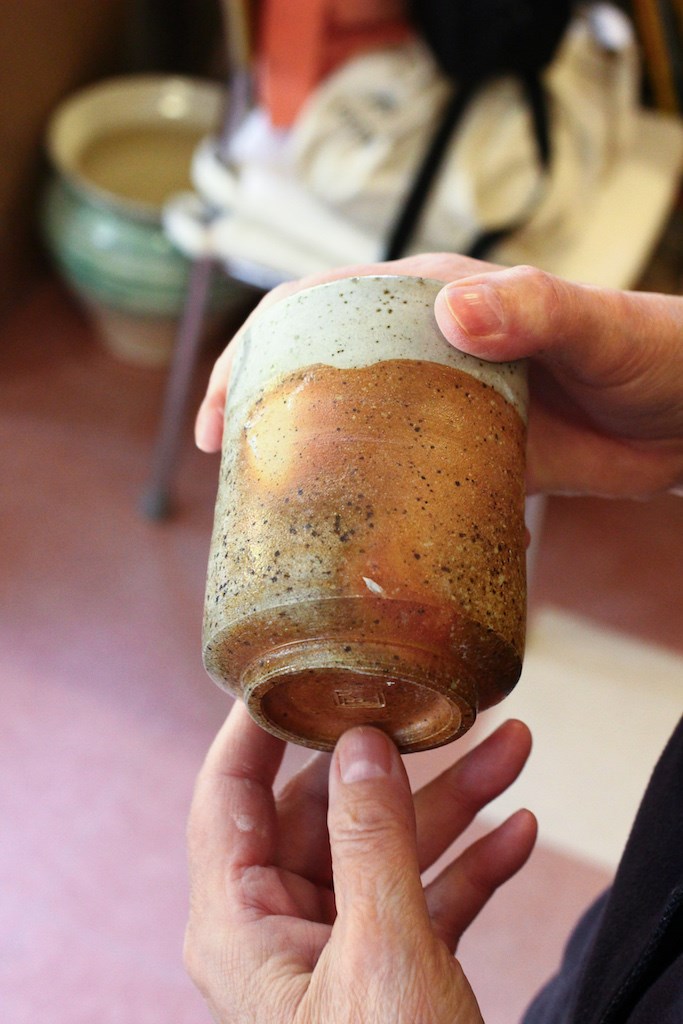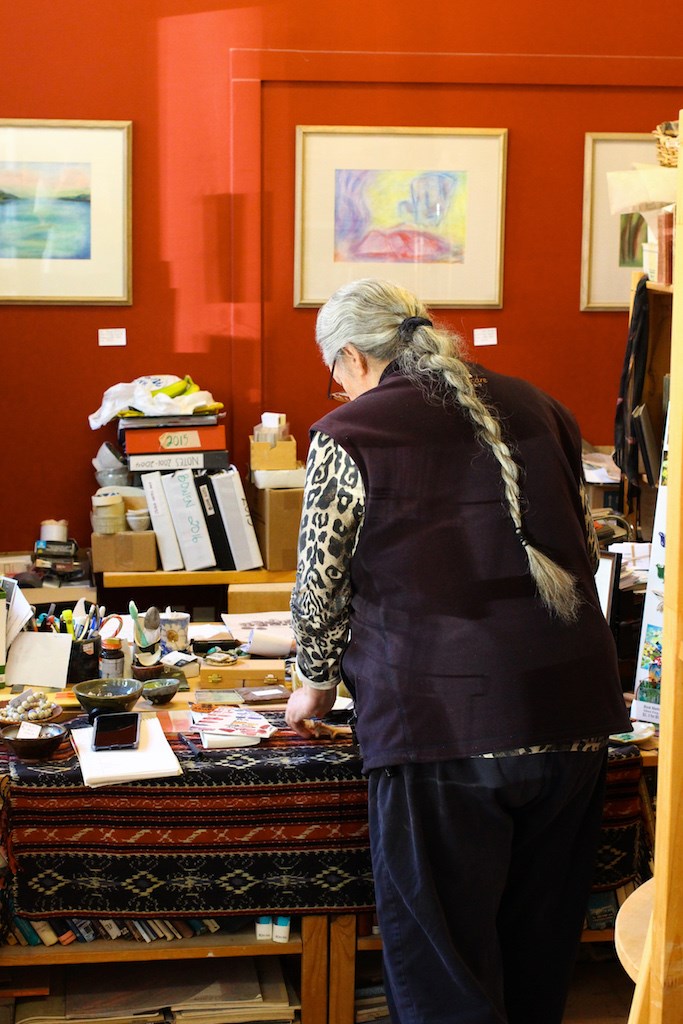On arrival to Jeanne Sarich’s ceramics studio, she appears lugging bags of clay, dust settling on her hands and forearms. Paints, brushes, glazes and sponges line the shelves behind her. There are days working with clay requires some heavy lifting, Jeanne explains. The reward is hours spent moulding, shaping and imprinting the earth. “I’m an experimenter, I couldn’t make the same thing over and over. My favourite thing is coming in here and just playing, that’s when the magic happens.”
Sounds of a piano and harp drift into Jeanne’s Cloudflower Clayworks at Artisan Square. “There’s a music teacher upstairs and it’s the soundtrack to my work day. She plays so beautifully I never really listen to my own music.”
Raised in British Columbia’s Surrey, Jeanne recalls building dams out of clay in a river with her brother. “I liked the feeling of clay and the musty smell, and that you could pretty much do anything you wanted with it. If you wanted to make a dog or a cat or something to drink out of, you could.”

Jeanne creates today with the functionality of her pieces in mind. Teapots, bowls, plates, and handleless cups inspired by the Japanese yunomi in a variety of her colourful handmade glazes feature in her studio.
It was a number of years before Jeanne settled on Bowen and established her ceramics base. Studying towards an arts degree in her twenties, she watched a woman roll out long snakes of clay one afternoon in the basement of the university’s theatre. “I watched her a while and she showed me the kiln and I thought, ‘Gee, I’d like to get involved with clay’.”
Working as a substitute teacher in Terrace, she discovered a kiln in the school’s furnace room and a pottery teacher who taught her the basics of throwing, moulding and firing clay. “I decided clay was really where I wanted my main focus to be and my career, even if it took a little while longer.”
Jeanne later returned to school to study ceramics for three years, following a stint selling Haida Gwaii art. She built her own wood firing outdoor kiln in the 1970’s with second-hand bricks and began firing pots.
Then came the glazes. Jeanne drew on techniques from Sung Dynasty Chinese and Momoyama Japanese ceramics. “The natural glazing process, that’s what drew me and got me learning a whole lot of chemistry about glaze make-up. It’s quite a magical process.” A trip to Tokyo in 1982 allowed her to learn from a Living National Treasure first-hand, specialising in the shino ware glaze.

Following Japan: a relocation to the Arctic. Jeanne worked with First Nations communities in the Canadian Arctic Archipelago as an arts and crafts officer, supporting the development of arts in towns as small as 300 people. It took some adjusting to the -50°C climate in winter. “The wind would be howling like the devil and I’d be in my goose parka five inches thick, moose hide gloves with a wool glove inside and seal skin boots.”
She says a number of the towns she worked in were still hunter-gatherer communities. Men would return home with tales of being chased from their ice fishing spots by polar bears. “A lot of them worked outdoors too. You’d see a carver in front of his house carving soapstone with a chisel and axe wearing a mask and the mask would freeze to his skin. It’s tough up there.”
In her free time in the Arctic, she ran ceramics evening classes with another New York artist in his studio. “We’d bundle up and trek out at night in -50°C for these classes. I also got really interested in square dancing. So that’s what we used to do, square dance and make ceramics at the studio.”
Jeanne’s surroundings provided her with inspiration to create, particularly the Northern Lights, which would wake her in the middle of the night with their crackling. “It scared me, it was frightening to see it the first time being so bright and loud. It’s like a zig zag pattern across the sky, like a curtain. Sometimes they were so close they felt like they could fall down on your head.”
Small community living appealed to Jeanne, she enjoyed being able to commute without a car and living somewhere she could really get to know people. “I wanted to set that up here for me in our society. I also knew I wanted to be a full time potter and live on an island.”
Bowen Island emerged as the perfect opportunity to do so. She bought her island studio in 1998 and lived amongst her pots and boxes while house hunting for three months. “My family didn’t support me, they thought I was crazy to be a potter. They never really offered much support throughout my life.

“I remember telling my father as a child I wanted to be a teacher, and he said, ‘Well you better save your pennies girl, because I’m not going to pay to educate a girl’. I grew up thinking that if I’m going to do something with my life it’s going to be on me, I can’t rely on other people.”
She enjoys combining the ancient techniques of glaze making with motifs inspired by her time spent in the outdoors– the ocean, forest, deer and fish often feature in her work. Jeanne also runs ceramics workshops frequently for children and adults. It’s therapeutic, she says, for people to get their hands on clay.
“On a practical level, it’s just something nice to do. But clay is cosmic dust. It’s the stuff of us... When an artist creates a figure out of clay, it feels like being very god-like.”
She notes throughout her life, clay has always been there for her. “To smell clay, to look at it, to squeeze it, shape it, fire and colour it, it makes me happy. To me, you have to ask yourself, ‘Well why am I here?’ I’m here to have fun. This is what I love. That’s how basic it is.”
This story was first published on womenclan.com by New Zealand journalist (now based on Bowen) Nicole Barratt. Reprinted with permission.



